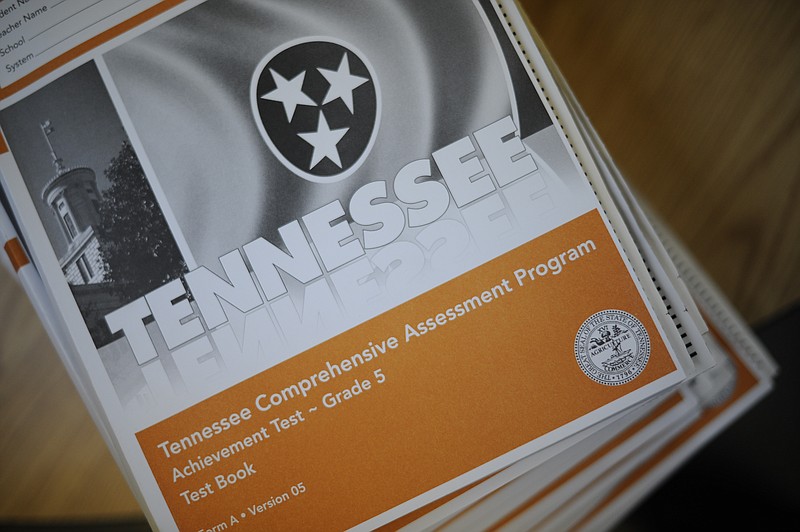Elementary school students in Hamilton County's public schools saw slight improvements in TNReady test results compared to last year, while students in middle and high school fell further behind.
The results, released Thursday by the Tennessee Department of Education, show that 34.3 percent of third- through fifth-graders are reading on grade level, compared to 32 percent in 2017. Statewide, 35.7 percent of students were on track or scored at a mastered level in English Language Arts this year.
Though the district continues to lag behind the state in several areas, Hamilton County's student results follow many of the trends statewide. But there is one caveat: many believe this year's data is not reliable.
The district- and state-level scores are the result of this spring's testing, which included a variety of mishaps, leaving many questioning if they are even accurate or what conclusions can be drawn from the data.
A plethora of issues with the state's testing vendor, Questar; a possible hack, which has since been retracted; even a cut fiber optic cable in the middle of the state caused weeks of headaches during the April testing window, leaving educators, students and parents frustrated.
This isn't the first year the state has experience problems with its testing system.
In 2016, Tennessee terminated its contract with Measurement Inc. after the North Carolina company's online platform fizzled in a number of districts, ending in a directive from Education Commissioner Candice McQueen for districts to halt testing. The state was then forced to suspend testing for grades three through eight after the company was unable to get backup paper tests to a number of schools.
In April, while holding the state's budget virtually hostage, the Tennessee House demanded senators and Gov. Bill Haslam agree to guarantee teachers' evaluations won't be at risk after the latest problems.
Though lawmakers ultimately voted to disregard this year's results when it came to teacher, student and school accountability, McQueen said this year's scores were valuable.
"TNReady serves as a vital feedback loop for teachers, parents, and administrators to tell us where we are, and the results inform what steps we need to take to help all students and schools succeed," McQueen said in a statement. "We are committed to improving implementation of TNReady so that parents, educators, and the department can continue to know how our students are doing each year."
Tennessee Education Association president Beth Brown disagrees.
"Even in a year where there are no issues administering the test, standardized test scores of a summative year-end, high-stakes test like TN Ready are not valid measures of student achievement, teacher effectiveness or school performance," Brown said in a statement. "Numerous studies have shown it is inappropriate to use standardized test scores and the resulting value-added scores to evaluate students or teachers. The state's use of these scores in high-stakes decisions unfairly penalizes students, educators and schools."
Of the 650,000 students who took TNReady across the state this year, about 300,000 did so online, according to the state.
The state contracted a third-party vendor, HumRRO, to audit the test results, McQueen said in a news conference. The vendor found that the only area possibly affected by testing problems involved middle school students, and otherwise had minimal impact on overall scores, McQueen said. She also acknowledged that the data had no way to measure student morale.
"We think these results reflect adequately what happened this spring," McQueen said. "We have no idea how these scores were impacted by student motivation one thing we can't quantify, the department can't or the district can't."
Even if the scores are accurate, they vary across the state.
Students in historically disadvantaged student groups saw improvements and gaps between student groups narrowed in multiple areas, according to state officials, however the data also shows overall decline in middle school performance.
In Hamilton County, middle school students performed worse in science, with 56.4 percent of students performing on track, down from 57.2 percent from 2017. Hamilton County's middle school students improved slightly in English Language Arts, with 31.9 percent of students on track this year, and fared about the same in math this year as last year, with 34.2 percent on track or above.
Statewide, student achievement was down in all three areas among middle school students, with 32.1 percent of students on track in ELA, 34.6 percent on track in math and 60.2 percent on track or mastered in science.
"To continue to see intense growth, we'll have to continue to intensely focus," McQueen said. "Until all students are proficient and all gaps are closed, there is no question we must continue to work."
Overall, Hamilton County saw decreases in a variety of areas, including in science across all grades, math performance among elementary and middle school students and in high school history, but Superintendent Bryan Johnson and his team seemed to be encouraged by some of the takeaways from the data.
"I think everyone in the state had the same issues. The data is useful in terms of planning and preparing and knowing where we are and how we compare to other districts," Johnson said during Thursday's school board meeting. "When you look at performance this year, you see gaps closing. This isn't where we want to be, or where the state wants us to be, but we see gaps closing."
Contact staff writer Meghan Mangrum at mmangrum@timesfreepress.com or 423-757-6592. Follow her on Twitter @memangrum.
